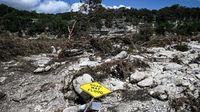On the morning of July 4, 2025, the small Texas community of Comfort faced a harrowing test as the Guadalupe River swelled with floodwaters rushing downstream. Unlike neighboring areas, Comfort was prepared—its sirens blared a long, flat tone, warning residents of the impending danger and prompting a swift evacuation. This early alert system likely saved lives, a fact underscored by the tragic loss of at least 118 people upstream along the same river, including 27 campers and counselors in nearby Kerr County, which lacked such a warning system.
Assistant Chief Daniel Morales of the Comfort Volunteer Fire Department, a veteran who has witnessed the devastating power of floods firsthand, believes the sirens were crucial. "We do for ourselves and for the community," Morales said, reflecting on the upgrades made to the warning system in 2024. Comfort, a community of more than 2,200 residents, managed to evacuate many people in time, avoiding the catastrophic toll that struck other areas along the Guadalupe River.
Morales’ connection to flood history runs deep. He recalls the deadly 1978 flood that claimed 33 lives, including 15 in Comfort and his own grandfather. That tragedy motivated the community to improve its emergency preparedness. Last year, the fire department spearheaded efforts to upgrade their siren system, cobbling together funds from grants, the county commission, their own budget, and donations from the local electric utility. The total cost hovered around $50,000 to $60,000—a modest sum compared to the nearly $1 million price tag for similar proposed systems in Kerr County, where funding attempts failed.
The refurbished siren was relocated to Comfort Park and connected to a U.S. Geological Survey sensor on Cypress Creek. This sensor triggers the siren automatically when water levels reach a critical point, but it can also be activated manually. For months before the flood, the volunteer fire department trained residents to recognize the siren’s signals. A daily noon test became routine, with clear messaging that any siren sounding outside this time signaled an emergency. Different siren tones distinguished between tornado warnings and flood alerts.
On July 4, when the floodwaters began rising rapidly, many Comfort residents were already awake and monitoring alerts. The sirens sounded at 10:52 a.m., shortly after the river crested at 10:45 a.m., giving residents a vital extra warning. Social media posts from the fire department urged mandatory evacuation for all residents along the Guadalupe River. Comfort’s location miles downstream from flash flooding sites like Hunt and Ingram allowed more time for preparation, but the sirens provided an additional layer of safety.
Meanwhile, Kerr County officials faced a starkly different reality. Despite monitoring weather conditions closely and issuing multiple wireless emergency messages starting before 5:30 a.m. on July 4, the county lacked a physical siren system. Fire Marshal Brady Constantine and County Judge Shane Stolarczyk worked tirelessly through the night and morning, setting up an Emergency Operations Center and coordinating evacuations. Yet, without audible sirens, many residents and campers at sites like Camp Mystic received little notice before the flash floods struck.
The absence of sirens in Kerr County has fueled calls for urgent action. Nicole Wilson, an Army veteran and San Antonio resident, launched a Change.org petition demanding modern outdoor emergency sirens for Kerr County. Nearly 40,000 people have signed, echoing her plea for an early warning system to protect families, schools, camps, and businesses from life-threatening emergencies. Wilson emphasized that the tragic loss of 27 children and counselors at Camp Mystic might have been mitigated with even five extra minutes of warning.
Flood warning systems rely on a combination of advanced weather forecasting, real-time data collection, and automated alerts. Sensors monitor rainfall, water levels, and stream flow, triggering sirens and text messages when thresholds are exceeded. The National Weather Service had issued flash flood warnings for Kerr County early on July 4, but local infrastructure for disseminating those warnings was lacking.
Nearly a decade ago, Kerr County sought $1 million to build a comprehensive flood warning system, including upgraded gauges, new sensors, and a public website for real-time information. Unfortunately, the Texas Division of Emergency Management repeatedly denied the request. While the county uses CodeRed software to notify residents via cell phones and expanded it in 2020 to reach people passing through the area, this system lacks the immediacy and reach of outdoor sirens.
Comfort’s success story stands as a testament to community initiative and collaboration. The county’s $70,000 upgrade in 2024—funded largely by a nonprofit and supported by Bandera Electric’s donation of poles—enabled the timely activation of sirens that morning. Morales and other officials are now considering adding a third siren to further enhance coverage, recognizing that expanding such systems across the county could save more lives.
As search and rescue efforts continue a week after the flood, with eight bodies recovered in Kendall County alone, the urgency for improved warning systems grows. County officials acknowledge that the siren system was a significant factor in their quick response and survival rates. Meanwhile, Wilson plans to testify during a special legislative session in Austin this month, urging lawmakers to prioritize funding for a robust early warning siren system in Kerr County. She hopes that Texas Governor Greg Abbott or President Donald Trump, who planned to visit the area on July 11, will help secure the necessary resources.
Comfort’s experience shows how preparedness, community investment, and technology can combine to save lives during natural disasters. But the devastating losses in Kerr County and calls for action remind us that the fight to protect vulnerable communities from sudden floods is far from over. As Morales said, "Anything we can do to add to the safety, we’re going to sit down and try to make it work." The stakes could not be higher.





